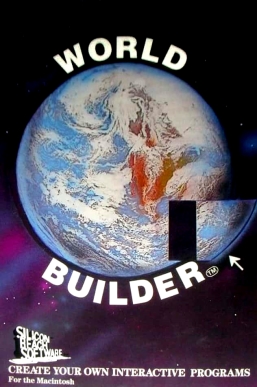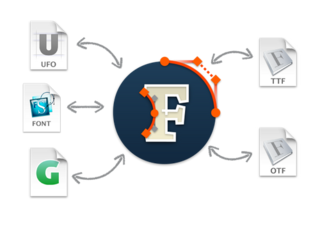Related Research Articles
HyperCard is a software application and development kit for Apple Macintosh and Apple IIGS computers. It is among the first successful hypermedia systems predating the World Wide Web.
An integrated development environment (IDE) is a software application that provides comprehensive facilities for software development. An IDE normally consists of at least a source-code editor, build automation tools, and a debugger. Some IDEs, such as NetBeans and Eclipse, contain the necessary compiler, interpreter, or both; others, such as SharpDevelop and Lazarus, do not.
Adobe Illustrator is a vector graphics editor and design program developed and marketed by Adobe Inc. Originally designed for the Apple Macintosh, development of Adobe Illustrator began in 1985. Along with Creative Cloud, Illustrator CC was released. The latest version, Illustrator 2023, was released on October 18, 2022, and is the 27th generation in the product line. Adobe Illustrator was reviewed as the best vector graphics editing program in 2021 by PC Magazine.

A/UX is a Unix-based operating system from Apple Computer for Macintosh computers, integrated with System 7's graphical interface and application compatibility. It is Apple's first official Unix-based operating system, launched in 1988 and discontinued in 1995 with version 3.1.1. A/UX requires select 68k-based Macintosh models with an FPU and a paged memory management unit (PMMU), including the Macintosh II, SE/30, Quadra, and Centris series.
Revolution is a software development environment/multimedia authoring software in the tradition of HyperCard and is based on the MetaCard engine. Its primary focus is on providing a relatively accessible development tool set and scripting language that enable the creation of software programs that run across multiple platforms with little or no code modifications. The Integrated Development Environment (IDE) included with Revolution is built partly on the models created by Bill Atkinson and the original HyperCard team at Apple and subsequently followed by many other software development products, such as Microsoft's Visual Basic. Revolution includes an English language-like scripting language called Transcript, a full programming language superset of the HyperCard's scripting language, HyperTalk.
Claris International Inc., formerly FileMaker Inc., is a computer software development company formed as a subsidiary company of Apple Computer in 1987. It was given the source code and copyrights to several programs that were owned by Apple, notably MacWrite and MacPaint, in order to separate Apple's application software activities from its hardware and operating systems activities.

System 6 is a graphical user interface-based operating system for Macintosh computers, made by Apple Computer. It was released in 1988, and is part of the classic Mac OS series. It is a monolithic operating system, with cooperative multitasking based on an improved MultiFinder. The boxed version cost US$49, and it was included with all new Macintosh computers until 1991, when it was succeeded by System 7.

Macintosh Programmer's Workshop (MPW) is a software development environment for the Classic Mac OS operating system, written by Apple Computer. For Macintosh developers, it was one of the primary tools for building applications for System 7.x and Mac OS 8.x and 9.x. Initially MPW was available for purchase as part of Apple's professional developers program, but Apple made it a free download after it was superseded by CodeWarrior. On Mac OS X it was replaced by the Project Builder IDE, which eventually became Xcode.
SuperCard is a high-level development environment that runs on Macintosh computers, under OS 8 and 9, and OS X. It is inspired by HyperCard, but includes a richer language, a full GUI toolkit, and native color.

Adobe Shockwave is a discontinued multimedia platform for building interactive multimedia applications and video games. Developers originate content using Adobe Director and publish it on the Internet. Such content could be viewed in a web browser on any computer with the Shockwave Player plug-in installed. MacroMind originated the technology; Macromedia acquired MacroMind and developed it further, releasing Shockwave Player in 1995. Adobe then acquired Shockwave with Macromedia in 2005. Shockwave supports raster graphics, basic vector graphics, 3D graphics, audio, and an embedded scripting language called Lingo.
Wingz was a spreadsheet program sold by Informix in the late 1980s and early 1990s. Originally developed for the Macintosh, it was later ported to Microsoft Windows, OS/2, NeXTSTEP and several other commercial flavors of Unix. In spite of many positive reviews, including one calling it "clearly the spreadsheet of the future", the market was rapidly entrenching Microsoft Excel. Informix eventually gave up on the desktop market and reverted solely to database sales in the mid-1990s. Claris licensed and sold an extensively cleaned up version as Claris Resolve in 1991, but it was far too late to market to have any effect.

Norton Utilities is a utility software suite designed to help analyze, configure, optimize and maintain a computer. The latest version of the original series of Norton Utilities is Norton Utilities 16 for Windows XP/Vista/7/8 was released 26 October 2012.

Kid Pix is a bitmap drawing program designed for children. Originally created by Craig Hickman, it was first released for the Macintosh in 1989 and subsequently published in 1991 by Broderbund. Hickman was inspired to create Kid Pix after watching his son Ben struggle with MacPaint, and thus the main idea behind its development was to create a drawing program that would be very simple to use.
Canvas X is a drawing, imaging, and publishing computer program from Canvas GFX for personal computers.

World Builder is a game creation system for point-and-click adventure games. It was released for Macintosh in 1986 by Silicon Beach Software and had already been used for creating Enchanted Scepters in 1984. On August 7, 1995, developer William C. Appleton released World Builder as freeware.
Omnis Studio is a rapid application development (RAD) tool that allows programmers and application developers to create enterprise, web, and mobile applications for Windows, Linux, and macOS personal computers and servers across all business sectors.

FontLab is a font editor developed by Fontlab Ltd., Inc. Since the early 2000s, it has been the dominant software tool for commercial/retail digital font development. FontLab is available for Windows and macOS.
Reunion is genealogy software made by Leister Productions, Inc., a privately held firm established by Frank Leister in 1984 located in Mechanicsburg, Pennsylvania. The company operates as a genealogy software developer exclusively for macOS and iOS. Reunion was initially a Macintosh application, programmed in Apple's HyperCard. Version 4 was available for Windows and Macintosh until the Windows version was sold to Sierra in 1997.
Central Point Software, Inc. was a leading software utilities maker for the PC market, supplying utilities software for the DOS and Microsoft Windows markets. It also made Apple II copy programs. Through a series of mergers, the company was ultimately acquired by Symantec in 1994.
A web browser is a software application for retrieving, presenting and traversing information resources on the World Wide Web. It further provides for the capture or input of information which may be returned to the presenting system, then stored or processed as necessary. The method of accessing a particular page or content is achieved by entering its address, known as a Uniform Resource Identifier or URI. This may be a web page, image, video, or other piece of content. Hyperlinks present in resources enable users easily to navigate their browsers to related resources. A web browser can also be defined as an application software or program designed to enable users to access, retrieve and view documents and other resources on the Internet.
References
- ↑ Cable, Jeff (September 1989). "Does HyperStudio Stack Up?". InCider. Vol. 7, no. 9. CW Communications/Peterborough. pp. 44–48. ISSN 0740-0101.
- ↑ "Roger Wagner Home".
- ↑ Weston Solomon, Ana (1999). Using HyperStudio for Windows and Macintosh: A Complete Tutorial. Course Technology. ISBN 9780538722308.
- ↑ Fleck, Tim (2001). HyperStudio 4 for Terrified Teachers. Teacher Created Resources. ISBN 9780743934565.
- ↑ "Software MacKiev - HyperStudio".